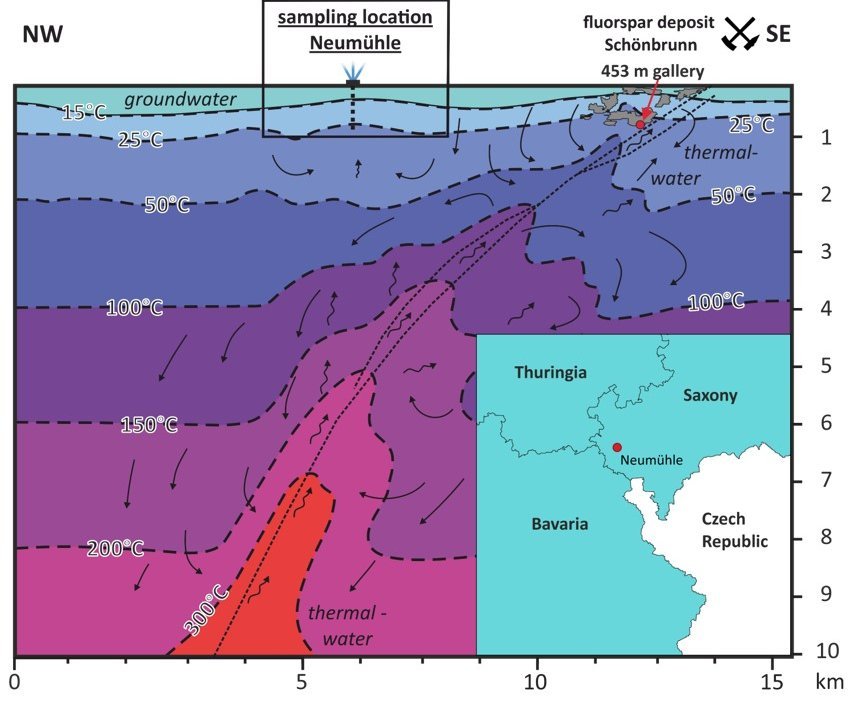Exploration of hydrothermal reservoirs in SW Saxony (deep geothermal energy) – E4Geo-2.3
The project E4Geo-2 (continuation project, duration 06-2023 to 11-2024) is aimed at exploiting fault-bound hydrothermal reservoirs associated with the granite pluton of Eichigt-Schönbrunn in SW Saxony. Aspects of the hydrochemistry and gas geochemistry of warm spring waters from the former fluorite mine Schönbrunn/Vogtl. and from Neumühle near Geilsdorf/Vogtl. are currently under investigation.

The project, which is the first pilot project targeting hydrothermal reservoirs in Saxony, is supported by three partnering institutes: Freiberg University of Mining and Technology (TU Bergakademie Freiberg), the Leibniz Institute for Applied Geophysics (Leibniz-Institut für Angewandte Geophysik, LIAG) and the GFZ German Research Centre for Geosciences (Deutsches GeoForschungsZentrum GFZ). Investigations follow an integrative multi-disciplinary approach involving the fields of (isotope-) geochemistry, geology, geophysics and geodynamics. The emphasis of the presented continuation project lies on aqueous and isotope geochemistry in order to decipher the (hydro-) geochemical characteristics of ground- and hydrothermal waters as well as of their dissolved gas contents at selected sites in the SW Vogtland region. Furthermore, petrographic and petrophysical investigations of the reservoir rock (granite) will commence as well.
Goals:
- Estimation of reservoir temperatures in the aquifer
- Gaining information on the origin and age of fluids
- Investigation of petrophysical rock properties (granite)
- Tracking of fluid transport processes
- Constraining the effects of geodynamic influences (mixing of ground- and hydrothermal waters, magmatic ascent in the Cheb Basin and swarm seismicity)
The project is funded by the Saxon State Ministry for Energy, Climate Protection, the Environment and Agriculture (Sächsisches Staatsministerium für Energie, Klimaschutz, Umwelt und Landwirtschaft, SMEKUL). The project’s duration is 17 months and a follow-up project is planned for 2025.
Participants
- Dr. Horst Kämpf (GFZ)
- Kai Mangelsdorf (GFZ)
- Dr. Simon Prause (GFZ)
Cooperation partners
- Prof. Dr. Stefan Buske, Freiberg University of Mining and Technology, Institute for Geophysics and Geoinformatics
- Prof. Dr. Gerald Gabriel, LIAG Hannover
Funding
- Saxon State Office for the Environment, Agriculture and Geology, Dresden (project management: Dipl.-Geoökol. Sascha Görne, Saxon State Office for the Environment, Agriculture and Geology)
Publications
- Schützel, H., Hösel G., (1962). Eine neue Mineralquelle im südwestlichen Vogtland und Bemerkungen zum Granitmassiv von Eichigt-Schönbrunn. Z. angew. Geol, 8, 404-408.
- Kuschka, E. (1998). Das Thermalwasser in der Flußspatgrube Schönbrunn im Vogtland. Fundgrube 1-2, 2-16.
- Weinlich, F. H., Bräuer, K., Kämpf, H., Strauch, G., Tesař, J., & Weise, S. M. (1999). An active subcontinental mantle volatile system in the western Eger rift, Central Europe: Gas flux, isotopic (He, C, and N) and compositional fingerprints. Geochimica et Cosmochimica Acta, 63(21), 3653-3671.
- von Storch, K. (1998). Herkunft der balneologisch wertbestimmenden Eigenschaften in sächsischen Mineral-und Thermalwässern (Doctoral dissertation, UFZ-Report 24/1998).
- Gottesmann, B., Förster, H.-J., Müller A.B., Kämpf, H. (2017). The concealed granite massif of Eichigt-Schönbrunn (Vogtland, Germany): Petrography, mineralogy, geochemistry and age of the Eichigt apical intrusion. Freiberg Online Geosciences, 49, 1-46.
- Bräuer, K., Kämpf, H., Niedermann, S., Strauch, G., & Tesař, J. (2008). Natural laboratory NW Bohemia: comprehensive fluid studies between 1992 and 2005 used to trace geodynamic processes. Geochemistry, Geophysics, Geosystems, 9(4), 1-30. doi: 10.1029/2007GC001921.



